
Hampton Court Palace is a royal palace which is located upstream of central London on the River Thames. The palace building project began in 1515 with Cardinal Thomas Wolsey as the owner.
However, in 1529, Wolsey fell from favor, and King Henry VIII seized the Palace for himself. Henry VIII enlarged the palace complex to cater to his large royal court. Today you can walk in King Henry VIII’s and his many wives’ footsteps.
“…to wish myself in my sweetheart’s arms,
whose pretty ducks [breasts],
I trust shortly to kiss.”
– King Henry VIII’s love letter to Anne Boleyn
In the following century, King William III rebuilt and expanded Hampton Court Palace, which destroyed much of the Tudor palace. The King intended to build a palace to rival Versailles.
Fortunately for us, the project ceased in 1694, leaving the Palace in two distinct architectural styles, domestic Tudor and Baroque.
King George II was the last monarch to live in the Palace, and today, the Palace is open to the public and displays many works of art from the Royal Collection.
The Place complex includes extensive gardens, a maze, a historic tennis court, and a vast grapevine.
A Virtual Tour of Hampton Court Palace
- Henry VIII’s Great Hall
- King’s Beasts
- Henry VIII’s Kitchens
- Henry VIII’s Wine Cellar
- Hampton Court Palace, Tradesman’s Entrance
- Hampton Court Astronomical Clock
- The Fountain Court
- Christopher Wren’s South Front
- The Chocolate Room
- Historical Exhibits at Hampton Court Palace
Henry VIII’s Great Hall – Hampton Court Palace

Henry VIII’s Great Hall is spanned by a large and sumptuously decorated hammer-beam roof, and its walls are hung with Henry VIII’s highest praised tapestries, The Story of Abraham.
The Great Hall was built between 1532 and 1535, making it the last medieval Great Hall built for the English monarchy. So impatient was the King for this Hall’s completion that the masons were compelled to work throughout the night by candlelight.

During Tudor times, this was the most crucial room in the Palace. In this Hall, the King would dine in state seated at a table upon a raised dais. During the Tudor period, the Palace was the scene of many historical events.
In 1537, the King’s much-desired male heir, the future Edward VI, was born at the Palace.
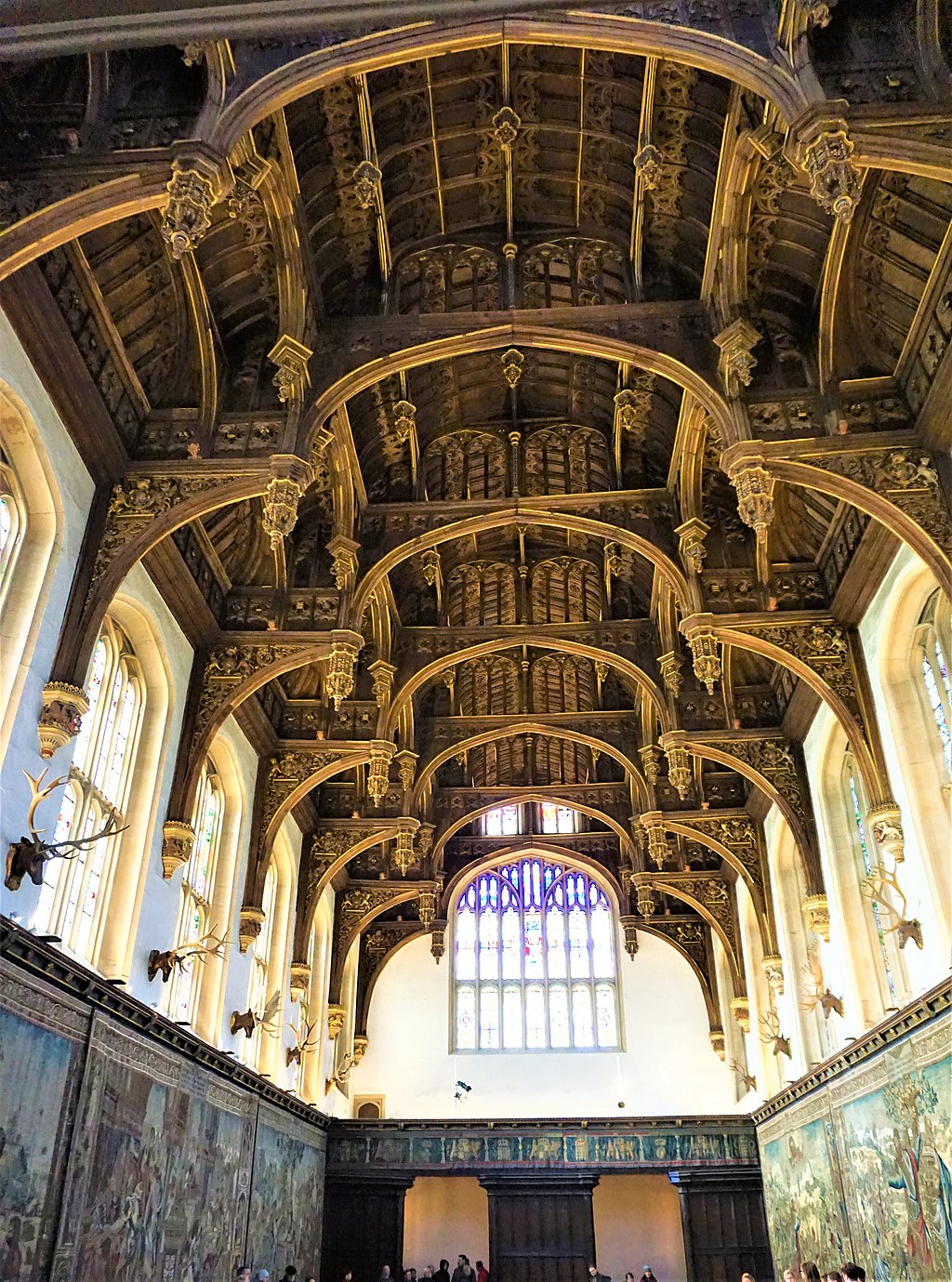
William Shakespeare’s company – the ‘King’s Men’ – performed for King James I over Christmas and New Year in 1603-4 in this Hall.
Henry VIII’s Great Hall
- Name: Henry VIII’s Great Hall
- Dates: 1530’s
- Historic Site: Hampton Court Palace
King’s Beasts – Hampton Court Palace

Ten statues of heraldic animals called the King’s Beasts to stand on the bridge over the moat leading to the great gatehouse. These statues represent the ancestry of King Henry VIII and his third wife, Jane Seymour. The animals are:
- the lion of England
- the Seymour lion
- the Royal Dragon
- the black bull of Clarence
- the yale of Beaufort
- the white lion of Mortimer
- the White Greyhound of Richmond
- the Tudor dragon
- the Seymour panther
- the Seymour unicorn.
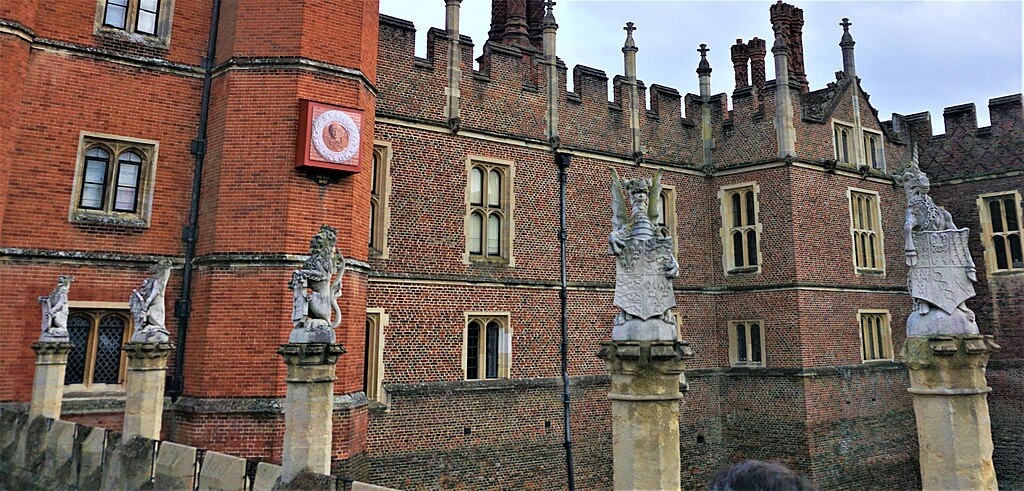
Jane Seymour (1508 – 1537) was Queen of England as the third wife of King Henry VIII.
She succeeded Anne Boleyn as queen consort following Boleyn’s execution and died of postnatal complications less than two weeks after her only child, a son who became King Edward VI.
Jane Seymour was the only one of Henry’s wives to receive a queen’s funeral, and his only consort to be buried beside him in St George’s Chapel at Windsor Castle.

Thomas Wolsey, Archbishop of York, Chief Minister and a favorite of Henry VIII, started building Hampton Court Palace in 1514.
However, in 1528, knowing that the King had turned against him and was engineering his downfall, Wolsey passed the Palace to the King as a gift.
The King almost immediately began his rebuilding and expansion. King Henry’s new Palace’s architecture followed the existing design of perpendicular Gothic-inspired Tudor with Renaissance ornament.
King’s Beasts
- Name: King’s Beasts
- Dates: 1530’s
- Historic Site: Hampton Court Palace
Henry VIII’s Kitchens at Hampton Court Palace

As soon as Henry VIII took ownership of Hampton Court Palace in 1528, the King began rebuilding and expanding to accommodate the King’s court, which consisted of over one thousand people.
Although the King owned over sixty houses and palaces, few of these were large enough to hold the assembled court, and thus one of the first building works to transform Hampton Court into a principal residence was to build the vast kitchens.

The kitchens were quadrupled in size, enabling the King to provide meals for his entire court. King Henry’s new Palace’s architecture followed the existing design of perpendicular Gothic-inspired Tudor with Renaissance ornament.

Successive Royals, including Queen Elizabeth I, used these kitchens. The quantities of meat procured for the Court in one year during Elizabeth I’s reign included:
- Sheep – 8,200
- Deer – 2,330
- Pigs – 1,870
- Oxen – 1,240
- Calves – 760
- Wild boar – 53
Henry VIII’s Kitchens
- Name: Henry VIII’s Kitchens
- Dates: 1529
- Historic Site: Hampton Court Palace
Henry VIII’s Wine Cellar – Hampton Court Palace
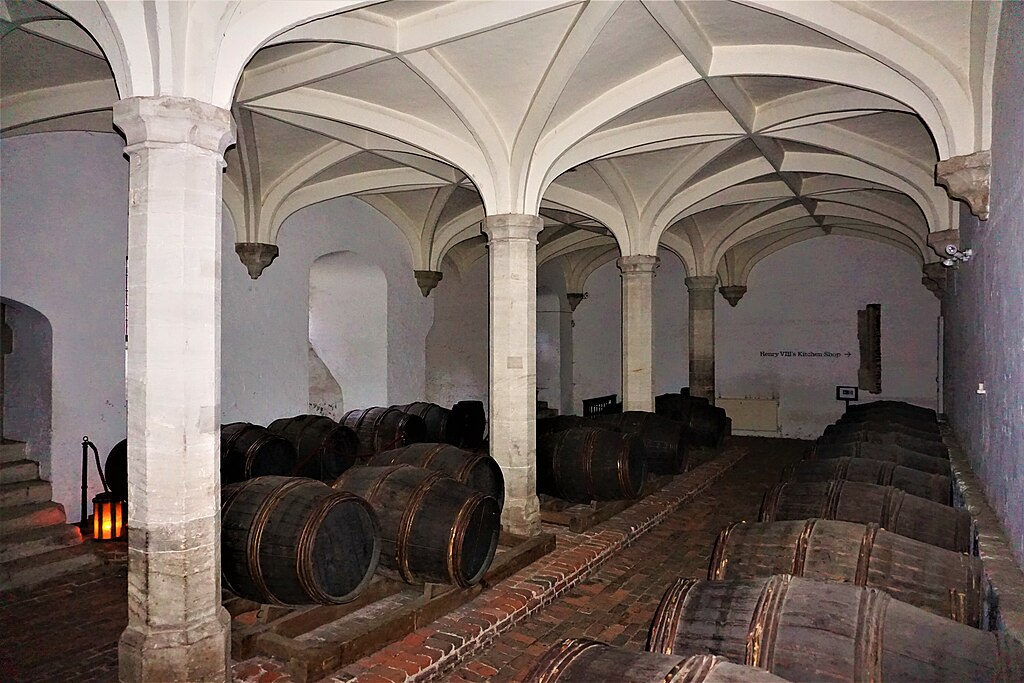
Tudor court meals were lavish affairs that all the sumptuous food was washed down with gallons of wine and beer. Court entertaining was provided in grand style to reflect the monarch’s magnificence, and King Henry kept his cellars well stocked.
Barrels of wine were sent from Europe and kept in cellars. The cellars are next to the kitchens, while beer was stored close to the Great Hall.
As soon as Henry VIII took ownership of Hampton Court Palace in 1528, the King began rebuilding and expanding to accommodate the King’s court, which consisted of over one thousand people.
Although the King owned over sixty houses and palaces, few of these were large enough to hold the assembled court, and thus one of the first building works to transform Hampton Court into a principal residence was to build the vast kitchens.
The kitchens were quadrupled in size, enabling the King to provide meals for his entire court.
Henry VIII’s Wine Cellar
- Name: Henry VIII’s Wine Cellar
- Dates: 1530’s
- Historic Site: Hampton Court Palace
Hampton Court Palace, Tradesman’s Entrance

Food produce was brought into the Palace through a ‘Tradesman’s’ entrance, where all goods passed under an archway into a cobbled courtyard. Here they were all unloaded and checked carefully.
A team of accountants, known as ‘The Clerks of the Green Cloth,’ kept detailed records to ensure accurate costs. The kitchen staff carried all the food products into a series of smaller kitchens or to the stores.
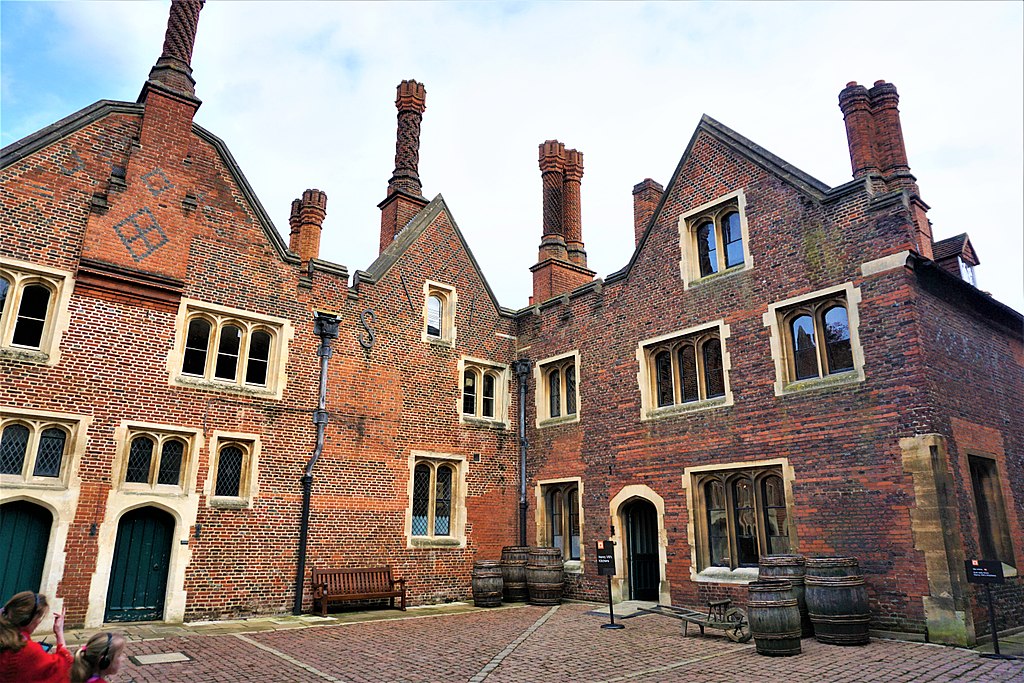
As soon as Henry VIII took ownership of Hampton Court Palace in 1528, the King began rebuilding and expanding to accommodate the King’s court, which consisted of over one thousand people.
Although the King owned over sixty houses and palaces, few of these were large enough to hold the assembled court, and thus one of the first building works to transform Hampton Court into a principal residence was to build the vast kitchens.

The kitchens were quadrupled in size, enabling the King to provide meals for his entire court. King Henry’s new Palace’s architecture followed the existing design of perpendicular Gothic-inspired Tudor with Renaissance ornament.
Tradesman’s Entrance
- Name: Tradesman’s Entrance
- Dates: 1530’s
- Historic Site: Hampton Court Palace
Hampton Court Astronomical Clock

The Hampton Court astronomical clock is a sixteenth-century astronomical clock with unique mechanisms and dials to display astronomical information, such as the sun’s relative positions, moon, zodiacal constellations, and sometimes major planets.
It was installed in 1540 on the gatehouse to the inner court at Hampton Court Palace. This clock is pre-Copernican, and a pre-Galilean astronomical clock and is still functioning.
The clock is 15 feet (4.6 m) in diameter with three separate copper dials revolving at different speeds and displays the following information:
- Hour, Month and Day of the month
- The position of the sun
- Twelve signs of the zodiac
- Number of days elapsed since the beginning of the year
- Phases of the moon
- Age of the moon in days

The clock also displayed the hour when the moon crosses the meridian and thus high water at London Bridge. Water high was important information to those visiting the Palace from London, as the preferred method of transport at the time was by barge.
Hampton Court Astronomical Clock
- Name: Hampton Court Astronomical Clock
- Dates: 1540
- Historic Site: Hampton Court Palace
The Fountain Court – Hampton Court Palace
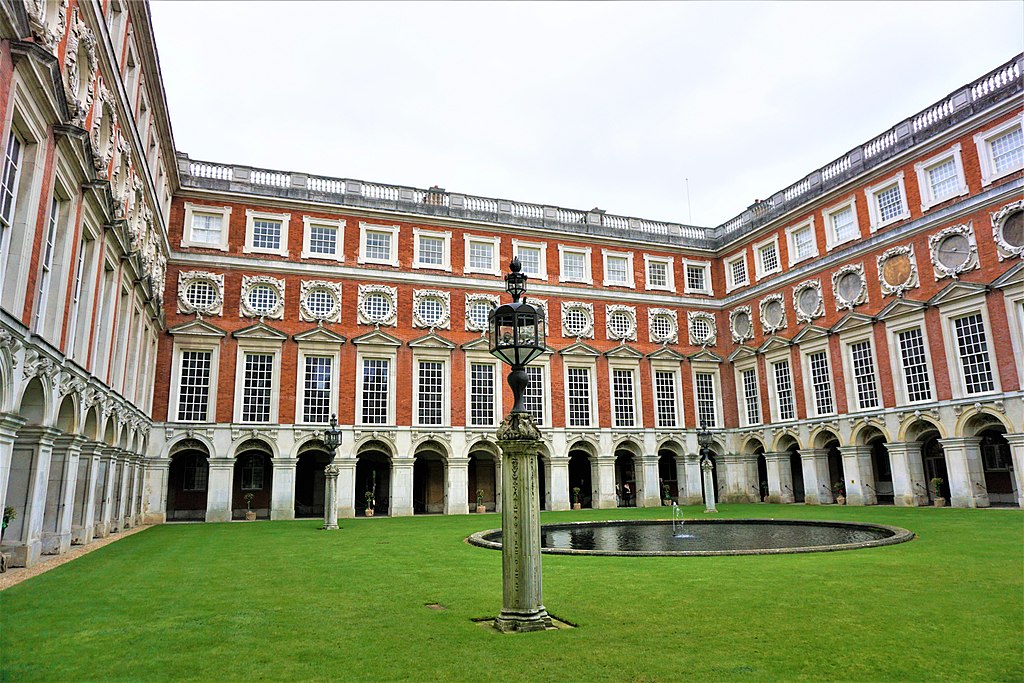
In 1689, shortly after Louis XIV’s court had moved permanently to Versailles, William III, and his wife, Mary II, embarked on a massive rebuilding project at Hampton Court.
The intention was to demolish the Tudor palace a section at a time while replacing it with a vast modern Palace in the Baroque style.
Sir Christopher Wren was called to design a new vast Palace. At this time, it was difficult for any sovereign to visualize a palace that did not emulate Versailles’ Baroque forms.
However, unlike Versailles, Hampton Court is different from its contrast between the pink brick and the pale Portland stone quoins, frames, and banding.
Further differences include the circular and decorated windows of the second-floor mezzanine. This theme is repeated in the inner Fountain Court, and the windows are given pointed pediments in the courtyard.
During the rebuilding effort, half the Tudor palace was replaced, and Henry VIII’s staterooms and private apartments were replaced.
The new wings around the Fountain Court contained new state apartments and private rooms, one set for the King and one for the Queen. After the death of Queen Mary, King William, lost interest in the renovations, and work ceased.
Thus the rest of the Tudor palace was not replaced with Versailles Baroque.
The Fountain Court
- Name: The Fountain Court
- Dates: 1690’s
- Designed by: Sir Christopher Wren
- Historic Site: Hampton Court Palace
Christopher Wren’s South Front – Hampton Court Palace

As viewed from the Privy Garden, Christopher Wren’s south front was built for William and Mary. Sir Christopher Wren was asked to design a new vast Palace at a time when it was difficult for any sovereign to visualize a palace that did not emulate Versailles’ Baroque forms.
Hampton Court, however, unlike Versailles, is different from its contrast between the pink brick and the pale Portland stone quoins, frames, and banding. Further differences include the circular and decorated windows of the second-floor mezzanine.
In 1689, shortly after Louis XIV’s court had moved permanently to Versailles, William III, and his wife, Mary II, embarked on a massive rebuilding project at Hampton Court.
The intention was to demolish the Tudor palace a section at a time while replacing it with a vast modern Palace in the Baroque style.
During the rebuilding effort, half the Tudor palace was replaced, and Henry VIII’s staterooms and private apartments were replaced. After the death of Queen Mary, King William, lost interest in the renovations, and work ceased.
Thus the rest of the Tudor palace was not replaced with Versailles Baroque.
The Fountain Court
- Name: The Fountain Court
- Dates: 1690’s
- Designed by: Sir Christopher Wren
- Historic Site: Hampton Court Palace
The Chocolate Room – Hampton Court Palace

The Chocolate Room is where Thomas Tosier, chocolate maker to George I (1714 – 1727) and George II (1727 – 1760), made the final touches to the King’s chocolate drink.
The room was used to store valuable serving equipment such as gold and silver Chocolate pots and the Chocolate drinking porcelain sets.
Christopher Wren built the Chocolate Kitchens in 1690 as part of William III’s and Queen Mary II’s rebuilding of Hampton Court Palace. Chocolate was relatively new in England, and its inclusion in the new part of the Palace demonstrated the modernity of William’s and Mary’s court.
Chocolate was an expensive luxury, and also, it was laced with exotic spices. The area around the Fountain Court was filled with kitchens and rooms for preparing and serving the most exceptional food.
There was also a Confectionary for making sweets and a Spicery where precious spices were stored and prepared.
Thomas Tosier was responsible for making and taking a chocolate cup to George I in his bed chamber every morning. The King’s chocolate maker also had his bedroom in the Court, a luxury and an honor for a servant at Court.
Thomas Tosier wasn’t only the King’s chocolate maker. He also owned a chocolate house on Chocolate Row in Greenwich, managed by his celebrity wife, Grace Tosier.
In the 1700s, chocolate drinking houses were popular with the upper classes and were identified as venues for luxury, sophistication, and good company.
The Chocolate Room
- Name: The Chocolate Room
- Dates: 1700’s
- Historic Site: Hampton Court Palace
Hampton Court Palace
- Site: Hampton Court Palace
- City: London
- Country: United Kingdom
- Type: Historic Royal Palaces
- Location: Hampton Court, Greater London, England
Hampton Court Secrets of Henry VIIIs Palace
Your Visit to Hampton Court Palace
Hampton Court Palace is a royal palace in the borough of Richmond upon the Thames, 11.7 miles (18.8 kilometers) south-west and upstream of central London on the River Thames.
Today, the Palace is open to the public. It is a significant tourist attraction, easily reached by train from Waterloo station in central London and served by Hampton Court railway station in East Molesey, in Transport for London’s Zone 6.
Also, London Buses routes 111, 216, 411, and R68 stop outside the palace gates.
Highlights of Hampton Court Palace
- Henry VIII’s Kitchens
- Two hundred cooks, sergeants, grooms, and pages worked to produce hundreds of meals every day for the household of Henry VIII.
- Henry VIII’s Great Hall
- Built for Henry VIII in the 1530s, the room is spanned and decorated with a large hammer-beam ceiling, and its walls are hung with historical tapestries.
- The Chapel Royal
- The Chapel Royal is a masterpiece of religious architecture with a vibrant design in Tudor style. Kings and Queens sat in their private pew, which looks down the main body of the Chapel.
- In 1540 Archbishop Cranmer handed Henry VIII the letter accusing Catherine Howard of her adulterous behavior.
- Haunted Gallery and Processional Route Walk
- Henry VIII’s route from his private apartments to the Chapel is the infamous Haunted Gallery.
- In 1541, Catherine Howard, the King’s fifth wife, discovered that she was to be charged with adultery, the charge for which her predecessor, Anne Boleyn, had been executed.
- Hampton Court Gardens
- The famous gardens include 60 acres of spectacular gardens and 750 acres of parkland, all close to the River Thames.
- Hampton Court Palace Maze
- The Kingdom’s oldest surviving hedge maze was commissioned around 1700 by William III. It covers a third of an acre and, on average, takes 20 minutes to reach the center.
- The Great Vine
- The Great Vine is over 250 years old and is the largest grapevine in the world. It was planted in 1768.
- National Plant Collections
- The Heliotropium which is also known as the ‘Cherry Pie Plant.’ It is a small purple flowers smell of cherry and vanilla.
- The Lantana and the Queen Mary II’s Exoticks are also designated a Heritage Collection.
HAMPTON COURT PALACE HENRY VIII Inside the KING & QUEEN’s Apts
History of Hampton Court Palace
Tudor Period
Thomas Wolsey, Archbishop of York and chief minister of Henry VIII, took over the site of Hampton Court Palace in 1514. Wolsey spent lavishly to build the most elegant palace in England at Hampton Court.
The first courtyard was his creation, the second, inner gatehouse, leading to the Clock Court. Wolsey’s seal remains visible over the entrance arch of the clock tower.
The Base Court contained lodgings reserved for guests, while the second court, Clock Court, held the state apartments.
Henry VIII stayed in the state apartments as Wolsey’s guest immediately after their completion in 1525.
Wolsey only enjoyed his Palace for a few years as in 1528, knowing that his enemies and the King were engineering his downfall, he passed the Palace to the King as a gift. Wolsey died two years later in 1530.
Within months of coming into ownership, the King began his rebuilding and expansion. Henry VIII’s court consisted of over one thousand people, while the King owned over sixty houses and palaces.
Few of these were large enough to hold the assembled court, and thus one of the first of the King’s building works was to build the vast kitchens.
The architecture of King Henry’s new Palace was perpendicular to Gothic-inspired Tudor with restrained Renaissance ornament.
This hybrid architecture remained almost unchanged for nearly a century until Inigo Jones introduced strong classical influences from Italy to the London palaces of the first Stuart kings.
Hampton Court Palace Tour – Home of King Henry VIII | Historic Royal Palaces
Stuart Period
On the death of Elizabeth I in 1603, the Tudor period came to an end. The Queen was succeeded by the Scottish King, James VI, who became known as James I of the House of Stuart.
In 1604, Hampton Palace was the site of King’s meeting with the English Puritans, which led to James’s commissioning of the Bible’s King James Version. King James was succeeded in 1625 by his son, the ill-fated Charles I.
Hampton Court was to become both his Palace and his prison. Following King Charles’ execution in 1649, the Palace became the Commonwealth’s property presided over by Oliver Cromwell.
Unlike some other former royal properties, the Palace escaped relatively unscathed. While the government auctioned much of the contents, the building was ignored.
After the Monarchy’s Restoration, King Charles II and his successor James II visited Hampton Court but mostly preferred to live elsewhere. By French court standards, Hampton Court was regarded as old-fashioned.
The new joint monarchs, William III and his wife, Mary II, changed that when they embarked on a massive rebuilding project at Hampton Court. The intention was to demolish the Tudor palace a section at a time and to replace it with a vast modern palace in the Baroque style.
Half of the Tudor palace was replaced, and the new wings around the Fountain Court contained new state apartments and private rooms, one set for the King and one for the Queen.
The King’s Apartments face south over the Privy Garden, the Queen’s east over the Fountain Garden. The suites are linked by a gallery running the length of the east façade, another reference to Versailles, where the Galerie des Glaces connect the King and Queen’s apartments.
After the death of the Queen, King William lost interest in the renovations, and work ceased. He was succeeded by his sister-in-law Queen Anne who continued the decoration and completion of the state apartments. On Queen Anne’s death in 1714, the Stuart dynasty came to an end.
Georgian Period
Queen Anne’s successor was George I; he and his son George II were the last monarchs to live at Hampton Court. Under George I, six rooms were completed in 1717.
Under George II, further refurbishment took place, with new furnishings and decor, including the Queen’s Staircase. Today, the Queen’s Private Apartments are open to the public and include her bathroom and bedroom.
Since the reign of King George II, no monarch has resided at Hampton Court. George III, from the moment of his accession in 1760, never set foot in the Palace.
Victorian Period
In 1796, during the reign of Queen Victoria, the Great Hall was restored, and in 1838, the Palace was opened to the public. Hampton Court railway station opened in 1849, and the Palace soon became a major tourist attraction, and, by 1881, over ten million visits had been recorded.

Royal Palaces in London
Royal palaces and castles in and around London include:
Tower of London
The Tower of London is a historic castle located on the River Thames bank in central London. It was founded in 1066 as part of the Norman Conquest of England.
The White Tower, which gives the entire castle its name, symbolizes oppression inflicted upon London by the new ruling elite. A grand palace early in its history, it served as a royal residence.
Today’s Tower is a complex of buildings and fortifications developed during the 12th and 13th centuries constructed within two concentric rings of defensive walls and a moat. The general layout established by the late 13th century remains on the extensive site.
Kensington Palace
Kensington Palace is a royal residence set in Kensington Gardens in London. It has been a residence of the British Royal Family since the 17th century. Today, the State Rooms are open to the public.
The Palace also displays many paintings and other objects from the Royal Collection. The Palace’s offices and private accommodation areas are used by extended Royal Family members and their families and remain the responsibility of the Royal Household.
Windsor Castle
Windsor Castle is a royal residence at Windsor, just outside London. It is notable for its long association with the English Royal family and its architecture.
The original castle was built in the 11th century after the Norman invasion of England. Since the time of Henry I, it has been used by the reigning monarch and is the longest-occupied palace in Europe.
The castle’s lavish early 19th-century State Apartments are completed in later Georgian design. The 15th-century St George’s Chapel is a historical example of English Perpendicular Gothic design.
Buckingham Palace
Buckingham Palace is the London residence and administrative headquarters of the monarch of the United Kingdom. The Palace is often at the center of state occasions and royal hospitality.
Formerly known as Buckingham House, the building at the core of today’s Palace was a large townhouse built in 1703 on a site that had been in private ownership for at least 150 years.
It was acquired by King George III in 1761 as a private residence for Queen Charlotte and became known as The Queen’s House. It was enlarged during the 19th century, with the construction of three wings around a central courtyard.
Buckingham Palace became the London residence of the British monarch on the accession of Queen Victoria in 1837.
Hampton Court Palace
Hampton Court Palace is a royal palace not far from central London on the River Thames. Discover Henry VIII’s favorite royal residence.
Visit Base Court and the breath-taking grandeur of King’s and Queens State Rooms. Stroll over 60 acres of enchanting gardens, lose yourself in the maze. Visit the Haunted Gallery and discover the Baroque Palace, full of history from the Stuart and Georgian era.
For 200 years, Hampton Court Palace was at the center of the English Monarchy’s court life, politics, and history. Its first royal resident was Henry VIII. Today Hampton Court is a short day trip from London.
The ghosts of Hampton Court Palace
King Henry VIII Quotes
“Of all losses, time is the most irrecuperable for it can never be redeemed.”
~~~
“Two beheadings out of six wives is too many.”
~~~
“I would not be a queen, For all the world.”
~~~
“In sweet music is such art,
Killing care and grief of heart
Fall asleep, or hearing die.”
~~~
“A peace above all earthly dignities,
A still and quiet conscience.”
~~~
“…to wish myself in my sweetheart’s arms,
whose pretty ducks [breasts] I trust shortly to kiss.” – a love letter to Anne Boleyn
~~~
Crown And Country – Hampton Court
~~~
“Two beheadings out of six wives is too many.”
– King Henry VIII
~~~
Photo Credit: JOM
Popular this Week








 Sponsor your Favorite Page
Sponsor your Favorite Page SEARCH Search for: Search Follow UsJoin – The JOM Membership Program
Sponsor a Masterpiece with YOUR NAME CHOICE for $5
Share this:
- Tweet
